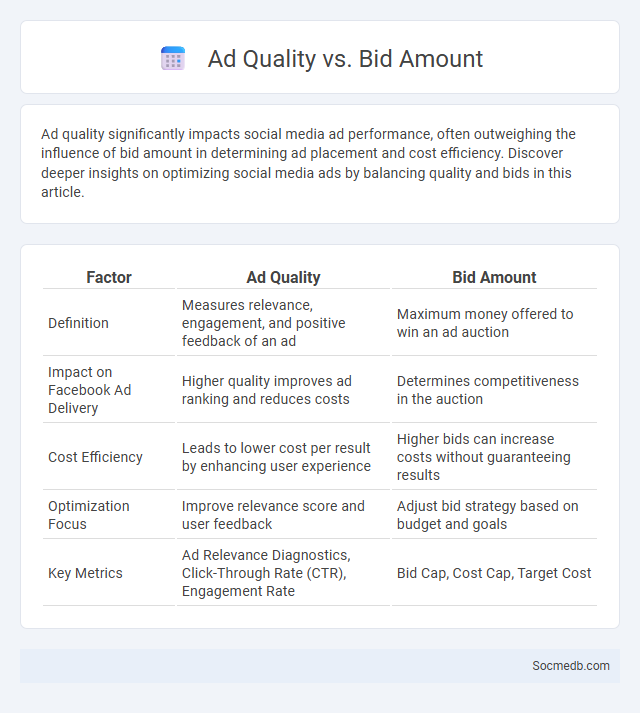
Photo illustration: Ad Quality vs Bid Amount
Ad quality significantly impacts social media ad performance, often outweighing the influence of bid amount in determining ad placement and cost efficiency. Discover deeper insights on optimizing social media ads by balancing quality and bids in this article.
Table of Comparison
| Factor | Ad Quality | Bid Amount |
|---|---|---|
| Definition | Measures relevance, engagement, and positive feedback of an ad | Maximum money offered to win an ad auction |
| Impact on Facebook Ad Delivery | Higher quality improves ad ranking and reduces costs | Determines competitiveness in the auction |
| Cost Efficiency | Leads to lower cost per result by enhancing user experience | Higher bids can increase costs without guaranteeing results |
| Optimization Focus | Improve relevance score and user feedback | Adjust bid strategy based on budget and goals |
| Key Metrics | Ad Relevance Diagnostics, Click-Through Rate (CTR), Engagement Rate | Bid Cap, Cost Cap, Target Cost |
Understanding Ad Quality in Digital Advertising
Ad quality in digital advertising on social media directly impacts your campaign's effectiveness and return on investment by determining how users engage with your ads. Platforms like Facebook and Instagram use metrics such as relevance score, click-through rate, and user feedback to assess ad quality, influencing ad placement and cost. Prioritizing high-quality creatives and targeting ensures your ads reach the right audience with meaningful content, maximizing campaign performance.
The Role of Bid Amount in Ad Auctions
The bid amount plays a crucial role in social media ad auctions, directly influencing ad placement and visibility on platforms like Facebook, Instagram, and Twitter. Your bid competes against others in a real-time auction system where higher bids increase the likelihood of winning ad space, especially during peak user activity times. Optimizing your bid amount based on target audience engagement and campaign goals can significantly enhance ad performance and return on investment.
How Ad Auctions Determine Winners
Ad auctions on social media platforms determine winners by evaluating bids based on a combination of bid amount, ad relevance, and user engagement metrics. The algorithm calculates a total ad score that prioritizes ads likely to provide value to users, ensuring your ad reaches the most relevant audience. High-quality ads with competitive bids are favored, which maximizes both advertiser ROI and user experience on the platform.
Ad Quality Score: Key Factors and Metrics
Ad Quality Score is a critical metric measuring the relevance and effectiveness of your social media advertisements based on factors like click-through rate (CTR), ad relevance, and landing page experience. High-quality ads improve user engagement and reduce costs by ensuring your content resonates with the target audience and provides a seamless experience. Optimizing these key factors will enhance Your campaign performance and maximize return on investment across platforms like Facebook, Instagram, and Twitter.
The Impact of Bid Amount on Auction Outcomes
The bid amount directly influences auction outcomes by determining the visibility and placement of your social media ads in competitive environments. Higher bids increase the likelihood of winning ad auctions, leading to greater exposure and engagement with your target audience. Optimizing your bid strategy ensures that your social media campaigns achieve desired reach and cost-efficiency.
Balancing Ad Quality and Bid Amount for Maximum ROI
Optimizing social media campaigns requires a strategic balance between ad quality and bid amount to maximize return on investment (ROI). High-quality ads enhance user engagement and relevance scores on platforms like Facebook and Instagram, reducing cost per click and improving conversion rates. Carefully adjusting bids ensures competitive placement without overspending, driving efficient budget allocation and sustainable campaign performance.
How Ad Auction Algorithms Work
Ad auction algorithms determine the placement and cost of ads on social media platforms by analyzing factors such as bid amount, ad quality, and user relevance. These algorithms use machine learning models to predict the likelihood of user engagement and maximize platform revenue by selecting ads that offer the highest combined value. Social media networks like Facebook and Instagram prioritize ads with better click-through rates and relevance scores, ensuring advertisers reach targeted audiences effectively.
Real-World Examples: Ad Quality vs Bid Amount
Facebook's ad algorithm prioritizes ad quality over bid amount to enhance user experience and maximize ROI for advertisers. For instance, a low-bid ad with high engagement and relevance scores on Instagram can outperform a higher bid ad with poor quality metrics, leading to better placement and lower costs. Real-world data from advertisers demonstrates that optimizing ad creativity and targeting often yields more efficient results than solely increasing the bid amount.
Strategies to Improve Ad Quality and Win More Auctions
Optimizing ad quality on social media starts with precise audience targeting using data-driven insights to match ads with user interests and behaviors, leading to higher engagement rates. Enhancing visual appeal through high-resolution images and compelling video content increases click-through rates, signaling platform algorithms to prioritize your ads in auctions. Regularly analyzing performance metrics and refining ad copy based on A/B testing results ensures continuous improvement, boosting your ad relevance score and winning more auctions efficiently.
Future Trends in Ad Auctions and Bidding Strategies
Future trends in social media ad auctions indicate a shift towards more automated, AI-driven bidding strategies that optimize campaign performance by analyzing real-time user behavior and engagement patterns. Advertisers will leverage machine learning algorithms to maximize ROI, utilizing predictive analytics to anticipate audience responses and adjust bids dynamically. Your marketing efforts can benefit significantly from adopting these advanced strategies to stay competitive in an increasingly data-driven advertising landscape.
 socmedb.com
socmedb.com